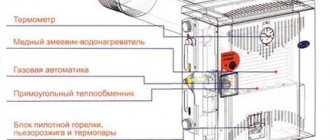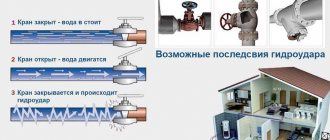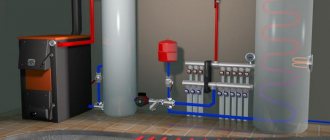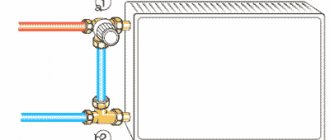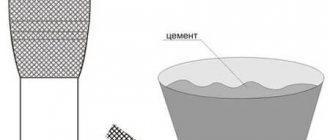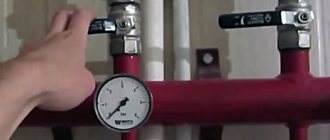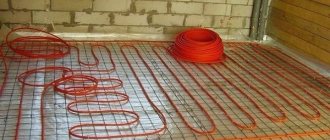About turning off batteries for the summer
Any water heating system must be filled with coolant year-round.
Getting air inside as a result of its emptying will not lead to anything good - all steel elements will begin to actively corrode until the moisture leaves. Given the enclosed space, this will not happen soon, and the empty pipes will be covered with a layer of rust from the inside. In centralized systems, it is impossible to understand whether there is water in the batteries in the summer; one can only hope for the integrity of the relevant services. As practice shows, you only need to rely on yourself. Therefore, in order to extend the service life of heating devices and prevent them from emptying, you need to choose the right moment at the very end of the heating season and turn off the valve on the battery installed on the outlet pipe. In the event of some repair work on heating networks, workers can drain water from the riser, but it will not leave the closed radiator.
Advice. You don’t have to worry at all about whether you need to shut off the radiators in the summer when your apartment has heating appliances made of cast iron. Unlike other materials, cast iron is practically not subject to corrosion.
At the time of the autumn start-up of centralized heating, particles of dirt and rust move through the pipelines along with the coolant. Steel, aluminum and bimetallic batteries have small channel widths, which can become clogged quite quickly. So on the first day of launch, when you can hear the murmur of water in the pipes, you should not rush and open the taps. It is better to do this the next day, bleeding the air using the Mayevsky tap.
There is often a warning on the Internet that in the summer only one valve to the battery should be closed, two - under no circumstances. Some say that after cooling, the water will decrease in volume and a vacuum will form in the radiator, causing it to crack (an example is given of a plastic bottle without air). Others say that the rupture will occur due to chemical reactions in aluminum batteries and the release of oxygen in all others. Excessive pressure will appear, which will supposedly rupture the device.
Such statements have no basis. The lowest operating pressure is for cast iron batteries and is 9 Bar, the destruction pressure is even higher. Not a single chemical reaction of the coolant with any metal can create such excess pressure, but for aluminum radiators the limit is even higher - 16 Bar. The example with a vacuum does not stand up to criticism at all; if it suddenly forms, then the force of external influence on the walls of the battery will be 1 Atm, that is, 1 Bar.
How to shut off a heating riser
The heating riser belongs to common property. It must be blocked by employees of the service organization who have the right to do so.
If you follow the letter of the law, you must come to the DEZ, Housing Office, DEU, etc., write an application, pay for the service at the cash desk. At a certain time (indicate in the application) a representative of the service organization must come and turn off the valve in the basement.
How much does it cost to turn off the heating riser? This is not an easy question. The fact is that there are no fixed prices. There is a price list for services, but it is only a recommendation. In reality, each organization sets its own prices. On average, you will have to pay from $15 to $20 for this operation.
The valve that shuts off the heating supply is located in the basement of the house
There is a workaround. Agree with neighbors and shut off the riser yourself without the campaign’s knowledge. But you know that this is not always possible: neighbors are different. If in the summer, when the heating is turned off, such actions may meet with understanding, then during the season - it is unlikely. There is another difficulty: the heating valve is not always easy to find. You either need to have a communication scheme, or just know where it is. They usually know a locksmith. But they won’t block the riser for free, and will require at least $10-15. There seem to be savings, but they are small. And if this fact becomes known to the management or operational company, you will face substantial fines.
How to turn off the radiator in an apartment
Almost all work with elements of the heating system requires turning off the radiators, and sometimes even dismantling them. Even such a relatively simple operation as painting. performed on a cold surface. It is easier to do it after removing the radiator, this ensures full access from all sides. If more complex operations are required, such as replacing or repairing a radiator, then you need to know how to shut off the radiator.
The task of turning off the radiator is complicated by the fact that there is coolant inside it all year round. Draining water from the heating system is carried out only in case of repair, since leaving the radiator without coolant for a long period of time leads to corrosion.
The fluids inside the radiator contain small amounts of dissolved oxygen. After a certain period, all the oxygen contained in the water reacts with the metal elements of the heating system and corrosion stops. After the coolant is drained, air enters the system and, in combination with water vapor, especially hot water, corrosion intensifies. Therefore, it is correct to drain the coolant only in exceptional cases.
Crimping
When the heating is turned on (at the beginning of the water supply to the network), the plumber should be near the tap in the basement in order to quickly shut off the water supply in case of an emergency. The procedure for supplying coolant under pressure into the system is called “pressure testing”. At the same time, the integrity of the heating system is checked.
When performing pressure testing, special equipment is used: a pressure gauge and a pump, which creates pressure. If the pressure in the system does not drop when coolant is supplied, then there is no leak in the network. If the pressure drops noticeably over time, it means that the tightness of the system is broken, and it is necessary to find damage to the lines and heating devices.
Bypass device and its functions
In winter, it is not allowed to close the common riser, with the exception of emergency situations. The presence of a bypass allows you to carry out repairs without turning off the heating system of your neighbors. The device is made of pipes with a smaller diameter than the supply and discharge lines. Two ball valves allow you to properly shut off the battery even if it’s hot, directing the water circulation through the bypass.
When replacing the radiator, the water is shut off, and after the work is completed, it opens again. If the room is hot, the bypass again allows you to temporarily shut down the system: hot water stops flowing into the battery and the room is cooled. But it is better to install thermostatic valves to regulate the temperature, maintaining a normal temperature in the room.
Using such a device, the radiator can be properly disconnected from the system at any time if it is necessary to perform painting, washing, replacing batteries, as well as when changing gaskets and nipples without blocking the risers.
Correct Bypass Installation
The bypass functions, depending on the type of heating system, are as follows:
- Energy carrier adjustment. When the room temperature is higher than normal, the thermostat reduces the supply of hot water, which negatively affects the operation of the entire system. This device is used to return coolant that did not enter the battery into the system.
- Emergency adjustment of coolant circulation in a system with an electric pump. When a power failure occurs, a bypass with a valve closes the hot water supply tap to the pump through the bypass pipe, at which time the valve opens and the coolant is directed through the central pipe. In this simple way, the system goes into a state of natural circulation without the participation of a pump.
- Reanimation of a single-pipe system. It works quite effectively: apartments are warm, even hot. The bypass also helps out in this situation, allowing you to reduce the supply of hot water, thus acting as a thermostat.
Thermostat on the radiator
The bypass must be installed next to the radiator. It is recommended to make the bypass pipe directly on site during installation using a welding machine. You can also use ready-made equipment on threaded connections. The control valve or radiator thermostat must be located between the radiator inlet and the bypass.
The supply side is equipped with a valve with a thermal head.
Heating Systems Basics
In general, according to the regulations of utility services, it is prohibited to interfere with the operation of the central systems of the house. In exceptional cases, when the battery is leaking or has ruptured, emergency intervention is permitted. But if the heating system in your home is connected to the central system correctly, then you can try turning off the heating yourself. There is nothing particularly difficult about this.
Correct connection means that the heating is connected to the general system using two ball valves (Figure 1) and a jumper called a bypass (Figure 2). This connection is called one-pipe. (Figure 3)
Figure 1 – Two taps
Figure 2 – Bypass jumper
Figure 3 – One-pipe system with a jumper. It can be covered
Important Modern heaters are filled with water, which plays the role of a coolant. In winter, hot water flows through the heating pipes, and cold water in summer. Oddly enough, it is filling with water that saves the insides of the radiator from rusting from the inside. After all, if all the water is drained from the heating system, then its remaining drops will create a microclimate for the formation of corrosion.
If you need to shut off and remove the radiator
It is best to carry out work related to radiator removal after the end of the heating season. If work needs to be carried out during the heating season, you need to take into account a number of nuances. If you have a single-pipe heating system and vertical wiring, you can remove the battery only if there is a bypass.
Such a system can be identified by pipes, one of which comes from the ceiling and connects to the radiator, and the other comes out of the radiator and disappears into the floor. A bypass is a jumper connecting the incoming and outgoing pipes. This is a pipe of approximately the same or slightly smaller diameter than the main pipes. The principle of the bypass is as follows: if the radiator is turned off, water begins to flow through the riser, passing through the bypass, without passing through the battery. In this case, the riser works, the heating in neighboring apartments does not turn off.
If the system is two-pipe, if there are taps, it is enough to close them, after which you can remove the battery.
Tool preparation
Before replacing, you need to prepare a special tool:
- Electric drill,
- Drill for working on concrete of the appropriate diameter,
- Angle grinder (“grinder”) with a diamond disc for processing metal surfaces,
- Tape measure and folding meter,
- Construction pencil, which will be used for marking,
- Water level (“spirit level”).
Important! If you are unable to reach an agreement with your neighbors above or below, you will need a tool, which is necessary for cutting threads. The external thread is cut on the pipe near the floor and under the ceiling.
The next stage is marking the position of the radiator on the wall and pre-assembling the components.
How to make a house warmer without heating devices?
This situation, such as the rapid cooling of an apartment due to a decrease in atmospheric air, repeats itself annually. Owners should consider how they can improve the thermal efficiency of their living space. How can you make your apartment cool down more slowly, retaining the heat accumulated over the summer longer?
It is necessary to take care of insulating the house in advance. Experts say that up to 14% of heat evaporates through glass. Another 30 percent of thermal energy escapes through cracks in windows and doors. 15% of warm air leaks out of the house through the entrance opening or a broken window in the entrance.
The heating hasn't been turned on yet, but blankets and rugs no longer help? There are several ways to help solve the problem.
The recommendations are as follows:
Caulk up old window frames. This is one of the main ways to eliminate heat leakage. This kind of work is not difficult, it takes a small amount of time. And its cost is minimal. As a result, drafts in the apartment will disappear.
Seal cracks in door frames. This method will reduce your electricity bill by 15 percent. It is recommended to do the same with the entrance door in the vestibule.
Background information: such measures increase thermal efficiency by 20%!
Finish the external walls of the apartment with foam plastic or mineral wool. If you have enough money, you can think about insulating your apartment in this way, too; this technique gives a noticeable effect. Just don’t forget about sealing the interpanel seams of the building.
The price of replacing a heated towel rail in a bathroom in Moscow
Choose reliable craftsmen without intermediaries and save up to 40%!
Find out the price of replacing a heated towel rail in the bathroom
Feedback on the task
it was a pleasure doing business with you
Feedback on the task
Everything is ok, we recommend)
Feedback on the task
An excellent specialist. He did a good job and gave the right advice.
Feedback on the task
The quality was satisfactory, but in some places not everything was thought out. The master is polite and delicate. I recommend.
Feedback on the task
Everything is done efficiently and carefully.
Feedback on the task
Boris is a professional in his field, responsible, polite and neat. Definitely recommend! Thanks for the great job)
Feedback on the task
Amazing! Everything is done efficiently and carefully.
Feedback on the task
Great performer. He knows his stuff, approaches the task wisely, does the work very efficiently, not quickly, but since I am primarily for a well-done task, I was VERY happy with this approach. I highly recommend it. It's better to spend time, but do it well. Good luck with your new orders.
Feedback on the task
Great job. Promptly, efficiently. I recommend.
Feedback on the task
The master arrived the next day, the work was done quickly and efficiently. Water does not drip. The battery heats up. The master returned the extra 1000 (forgot that he gave money for the purchase of materials). I recommend!
- Compare conditions and choose the best
- Feedback only from interested specialists
- Don't waste time communicating with intermediaries
Replacing a heated towel rail in a bathroom is now increasingly required, since standard pipes installed in apartments no longer meet the requirements for functionality, quality and design. However, you should understand that to replace the pipes of a heated towel rail you need not only to have a special tool, but also certain skills.
If you do not have the skills to replace heated towel rail pipes in bathrooms, seek help from Yudu specialists who have experience and will do the job quickly and efficiently.
Replacing a heated towel rail in the bathroom: price for services
If you want to replace a heated towel rail in your bathroom, the cost of the process is certainly important. The cost of replacing a heated towel rail in a bathroom from Yudu performers is lower than the rates from competitors. Since our specialists work without intermediaries, they have the opportunity to adjust the price for replacing pipes in bathrooms depending on the situation. The standard price for installing a heated towel rail depends on several factors:
- Type of construction
- Work time
- The need for additional activities
- Type and volume of consumables
- Difficulties in dismantling the old structure
The approximate cost of replacing a heated towel rail is indicated in the price list on the Yudu website. You can look at the cost of replacing heated towel rails in bathrooms, navigate the tariffs and determine the amount that will be most acceptable to you.
Please note that if you urgently need to change the heated towel rail in your bathroom, the price may differ from standard rates. The same applies to situations where a heated towel rail of a non-standard design needs to be replaced
The cost of services for replacing plumbing pipes for any purpose is determined individually and discussed between the contractor and the client.
To replace the heated towel rail in the bathroom, you just need to contact Yudu. Fill out the application on the website and indicate:
- Type of services
- Contact information
- The time when the specialist should arrive
- Address where work needs to be carried out
After placing an order, wait a while for candidates to read your terms and conditions. Specialists who meet the requirements will send you their proposals and then all you have to do is choose the best, but for this you need to carefully read each one.
When choosing a specialist, we recommend taking into account his rating and studying the reviews that clients leave about the work of specialists.
Remember that the battery is always filled with water
The battery is filled with liquid throughout the year. Water is drained only for a short time during centralized repair work. Therefore, if you plan to replace the battery, simply disconnecting it is not enough - you need to drain the water. Why is the system constantly filled with coolant? It is highly undesirable for oxygen to enter the heating system. When the water drains, air and water vapor take its place. This leads to active oxidation - that is, the appearance of rust on the surface of steel and bimetallic batteries. Oxygen dissolved in the coolant does not destroy the metal, i.e. does not lead to corrosion. Therefore, in order for the heating system to last a long time, it is always filled.
Features of turning off the heating riser
If the heating system is used for a long time, it requires regular repairs. In apartment buildings, this system is fixed on the riser. Disabling the heating riser involves a sequence of certain actions in accordance with legal requirements. In the article you can familiarize yourself with the procedure for blocking the riser and the necessary approvals.
There are a number of situations in which it may be possible to limit the functioning of pipes in the heating system. An apartment building implies the constant presence of liquid in the batteries. This could be water or antifreeze.
In summer the liquid is cold, and in winter it is hot. It is due to the high temperature of this liquid that the rooms are maintained warm.
It may be possible to turn off the heating riser if the following situations occur:
- installation of new radiators or their removal for maintenance and repair;
- repair work in the heating system;
- replacing fluid in the riser.
Turning off the heating riser due to a change of fluid in it is rarely done, since the less the inner surface of the pipes comes into contact with air, the longer the time it will be in working condition. Radiators inside are subject to corrosion; the degree of this destructive process directly depends on the type of material of the heating device. You can read about the differences between radiators made of steel, cast iron and aluminum, their advantages and disadvantages in the following article on our website.
The process of turning off the heating riser
Since the heating system requires regular monitoring of its condition, its operation must be monitored by the owners of residential premises.
Also, repairs and maintenance can be carried out by a management company with which a corresponding agreement is concluded. According to Article 36, Part 2 of the Housing Code of Russia, the heating riser belongs to the common property of a residential apartment building.
If it is necessary to dismantle, repair or replace heating radiators, the homeowner submits an application to the management company.
A list of required documents is attached to the application, and the specialists identified in the application can begin working with the heating system. The management company turns off the heating riser to avoid an emergency.
Sequence of actions when disconnecting
When it is necessary to turn off the heating riser, it is necessary to agree in advance on the date and time with the management company.
The easiest shutdown process is in summer, but shutdown is more difficult in winter. However, even at low temperatures, the management company must consider the homeowner’s application and determine the degree of urgency of this work.
The legal procedure for turning off the heating system in an apartment building is as follows:
- An application is submitted to turn off the heating riser. It is accompanied by the necessary documents from the company that identified faults that need to be corrected.
- The homeowner is required to first purchase the necessary structural elements of the riser. The sizes and their quantity are specified in the application.
- The date and time of the shutdown is agreed upon.
Before connecting new heating equipment, in particular radiators, the management company checks their condition. The correct functioning of the heating system and the absence of damage to the riser is also monitored by representatives of the management company.
After repairs and changes to the heating configuration, the entire system may need to be changed. This is quite difficult to do. The reasons for the likely difficulties should be considered the need to move the riser and make changes to the system configuration in some neighboring apartments.
Do I need to shut off the radiators while cleaning the system?
To ensure radiators have a long service life, when flushing the system by the management company, a number of conditions must be observed. These include:
- New batteries should be covered for the first 2 years after installation, as they are still quite clean. In this case, washing can only clog them. It will be possible to open the shut-off valves a couple of days after the completion of the work, after all the precipitation has gone away.
- Flush radiators yourself at least once every 2 years. This should be done with running hot water.
Instructions for cleaning batteries yourself:
- cover the bathtub with oilcloth;
- put a thick cloth on top;
- close all shut-off valves;
- remove the radiator;
- remove all gaskets;
- rinse the battery with a strong stream of hot water (you can use a shower hose);
- install the radiator, not forgetting to return all gaskets to their place.
What to do with a stuck ball valve
If ball valves are not rotated for years, they tend to sour and jam. In such a situation, do not try to resolve the issue physically and do not force the “butterfly” with pliers or a gas wrench. It is made of a brittle alloy and will probably break. Proceed like this:
- Unscrew the locking nut and remove the butterfly handle from the stem.
- On most of these valves, you will find a nut under the handle that clamps the plastic seal. Loosen it by turning the wrench half a turn. If there is no nut, go to the next step.
- Take an adjustable wrench or other device that allows you to securely grab the flats on the rod. Without applying much force, turn it as far as possible.
- When you feel resistance, turn the rod back all the way and forward again, trying to turn it a few more degrees. Work carefully and without haste!
- In this way, rotate the valve 90°, then tighten the gland nut and reinstall the handle.
An adjustable wrench can be used to firmly grasp the edges
Advice. If you have WD-40 spray lubricant in your household, apply it to the stem and wait 5-10 minutes before rotating.
Be doubly careful when turning off radiators with soured taps during the heating season. If you hurry too much and apply too much force, you will break off the metal rod or ball, and in the worst case, the valve body will burst. A stream of hot water can shoot out from the crack, which can burn you. While you go down to the basement and close the heating riser, the coolant will cause damage to the interior of the room, and you can roughly guess how much it costs to renovate the apartment now.
If you are not sure of your actions, call a plumber. More information on how to close a jammed ball valve in order to disconnect the radiators is described in the video:
The principle of adjusting the temperature of heating radiators
It is directly related to the design features of this element and its installation. The valve is a ball with a through hole.
The operation of the crane is controlled using a handle fixed to the ball by a rod.
Important! To install the device, you need to choose the location wisely so that turning the handle in the future does not interfere with other devices of the heating system. The diameters of the tap and pipe must be identical.
The diameters of the tap and pipe must be identical.
The device must be fixed in parallel
as it is twisted using tow or special tape. They provide the mechanism with additional protection against leaks. The correct installation is further verified by applying water pressure.
Photo 1. Ball valve device for adjusting the temperature in a heating radiator. Arrows indicate parts of the product.
Activating the handle promotes the movement of the mechanism around its own axis. Rotating the ball hole to the nozzles and pipeline inlets makes it possible to circulate coolant through it
, otherwise the fluid flow will be blocked.
The ball in such mechanisms can be fixed and movable. In the first case, it is attached to the rod so that it remains completely static. The tightness of such a connection is ensured by bolts or disc springs.
The movable ball is capable of moving depending on the degree of water pressure on it
. Due to this possibility, this type of mechanism is more widespread than the first.
How to open a tap
This is done to supply the maximum possible amount of coolant in order to provide the room with heat. To adjust the mechanism, you need to turn the handle parallel to its own axis and the pipe.
For convenience, there are protrusions on the faucet body indicating restrictions on the degree of its opening. This is done counterclockwise.
How to close
With this action, the circulation of the coolant completely stops. This needs to be done when there is a need to reduce the radiator temperature to a minimum, for example, in the summer.
The handle of the device in the “closed” position should form an angle of 90 degrees with its axis and the pipeline.
According to the protrusions, the movement of the handle to stop the fluid circulation should be done
clockwise.
Reference.
In both situations, in the absence of a handle, it is possible to determine the position of the tap
by the groove
. If it is aligned with the pipeline and the mechanism itself, then its position is “open”, otherwise the fluid flow is blocked.
How to turn a jammed tap on a battery and adjust it
Often this situation arises if the position of the mechanism is not periodically changed and developed as a preventive measure.
Before taking directed steps to repair the device,
it is worth trying to do it yourself.
Attention! It is necessary to know in advance what the faucet is made of, since the use of additional mechanical tools can cause irreversible damage to the mechanism. The repair begins with unscrewing the fixing nut and removing the handle
The top of the rod is located under the handle
Repair begins with unscrewing the fixing nut
and removing the handle. The top of the stem is located under the handle.
DESIGN PLACE FOR PLAY
Create a separate space in the room where the baby will be awake. Let the toys lie there, a place will be “cleared” for rolling cars or building pyramids, and don’t let chairs, a table, or a closet get in the way. The child should play with pleasure, he needs a certain place for this. And at the same time, you should not worry that, having played too much, he will crawl in the wrong direction and hurt himself on the table leg, or turn the chair over on himself.
How to turn on the radiator correctly for the first time
A very important point is to turn on the central heating battery for the first time in your home. When a long period of time has passed, and the thermal power plant begins to supply water to our batteries, then usually the first water flowing through the heating systems is the dirtiest and rustiest. Imagine. You have just installed a brand new battery, one might say, off the assembly line, and suddenly a powerful stream of dirt is thrown in there. It is not surprising that many batteries become clogged precisely from the first such inclusion, and then we are surprised that out of 12 battery bends, only 8 are heated, the rest remain cold. To prevent this from happening, a jumper (bypass) is needed when installing the battery. If you have done the installation correctly, then set the position of the ball valves as shown in the figure:
In this case, the entire flow of dirt when turned on for the first time will go through the jumper, keeping your battery intact and safe. In this option, it is better to keep hot water running for several days. Of course, many are looking forward to when it will be turned on. However, my advice is, if you can’t wait a few days, wait at least one day. By the way, a detailed article on how to turn off the battery.
How to properly disconnect the battery
When carrying out plumbing work, the first question arises: how to turn off the heating battery? More precisely, how to do it correctly?
Radiator with taps
Having found out the fact that there is always water inside the heating system, we understand that even in the summer, when the heating is not working, the system must be turned off when replacing batteries. Although disconnecting the risers is sometimes necessary not only when replacing batteries, but also during other plumbing work.
Such plumbing work can be quite varied:
- repair of taps or thermal valves,
- pipe replacement (full or partial),
- revision of the elevator unit.
Preparatory work before shutdown
Is it possible to do the preparatory work yourself before changing the heating battery (see also installation of heating batteries)? What is the best way to choose a contractor?
There are a number of factors to consider when choosing a contractor.
- The price for quality services is higher than the cost of services provided by “handicraftsmen” or self-taught people,
- Entrusting the execution of complex plumbing work to mechanics from the housing office is a risky business, if only because the fact that the maintenance office belongs to government agencies does not mean that they will do the job efficiently,
- To perform many plumbing operations, certain permits are required,
- Reputable offices employ engineers with experience and experience, who prepare estimates and provide consultations,
- Professional structures try to work with high-quality materials and components (see also which radiators are better),
- A reliable company will offer a written contract, which will also spell out warranty obligations.
Practice shows that utility companies and maintenance offices, as a rule, strive to maintain their monopoly position when resolving plumbing issues. Most often, the price of resolving the “issue” in housing offices (or in the office lobbied by them) is too high.
Displacement of competitors occurs using various administrative methods:
- paper bureaucratic throwing,
- licenses are requested,
- There are obstacles to the admission of third-party craftsmen to carry out some work (disconnecting the riser, etc.).
Self-preparation
But many jobs can be done yourself before changing the heating batteries.
To do this, the instructions and sequence of work must be followed:
- Agree with the neighbors who are on the riser floor above,
- Agree with the neighbors who are located on the riser floor below,
- Prepare special tools and accessories.
When replacing pipelines of the main riser (from the exit from the heating radiator on the floor above to the entrance to the radiator on the floor below), the following points should be taken into account:
- This replacement of risers is the optimal plumbing solution,
- In this case, you can finance neighboring adapters, fittings and underwater pipes:
Important! When replacing pipes, the cost of the elements that will be located in neighboring premises is low. But this will provide a certain guarantee regarding the elimination of problems with the supply pipelines, will make the replacement process easier and will eliminate the need to replace heating batteries in the future.
Is water needed in the system in summer?
The main condition for long-term proper operation of radiators is the absence of corrosion, which can appear both in empty batteries and those filled with liquid without air access.
In fact, there should be water in the system at all times, regardless of the season. But many service companies neglect this condition and drain it immediately after the end of the heating period.
Utility services justify this by saying that in the summer they carry out repair work, during which the water in the systems interferes and has to be drained. In addition, many residents change radiators during repairs, which also requires a complete release of the system, especially if the entrance has a common riser. And constant filling and emptying causes loss of time and unnecessary financial costs.
But, since the water does not completely drain from the radiators, a humid environment forms inside, leading to deformation of the metal. Therefore, if the service company drains water immediately after the end of the season, the shut-off valves should be closed the day before.
It will be important to open the air bleed valves, which will help avoid excess pressure in the radiators, which most often occurs when the system cools down. The taps should be opened a few days before the start of the next heating season.
Is it possible to turn off the radiator in the summer?
All operating organizations state that they do not drain the system in the summer, but “drive” cold coolant. In reality, the system is drained: for repairs, replacement of pipes or equipment, etc. And although all radiator manufacturers say that it can stand without water for two weeks (or a week) a year, no one guarantees that the system will be filled in two weeks. This situation is not critical for copper and copper-aluminum radiators - copper generally has oxygen or not - it practically does not react to its presence in any way (after an oxide film has formed on the surface).
To avoid damage to radiators, many people close the radiators with ball valves after the end of the season. But you can’t do this: the battery can simply rupture.
If you turn off the radiator in the summer and do not open the air vent, the battery may simply rupture
The fact is that in the presence of water in the radiator, chemical processes occur, which are accompanied by the release of gases. When the taps are closed, the possibility of their exit is cut off. Gases accumulate more and more inside, creating excess pressure. Once it exceeds its tensile strength, the battery will burst. And this will not be a warranty case: the operating conditions have been violated.
This problem is relevant for aluminum ones. cast iron, bimetallic and steel radiators. That is, for everyone. But what to do? It’s both bad and bad. And the solution is this: shut off the battery, but at the same time open the air vent.
If you turn off the radiator for the summer, make sure that the air vents are open and in working order.
Today, every modern radiator has this device. Most often - the Mayevsky crane. This is a small washer with a hole, with the help of which it is necessary to bleed air after starting the system and during the heating season. In manual models, you need to use a wrench or a screwdriver to turn the screw counterclockwise. In automatic ones, bleeding occurs as air appears. But even here there is a screw cap that blocks the exit of gases. So here it is. If you decide to shut off the battery for the summer, make sure that the air vents are open and the air is released (not clogged). It also doesn’t hurt to make sure at least once a month that the air vent is still open, otherwise you never know: the children were playing, or someone absent-mindedly twisted it...
What is required to shut off heating appliances?
If it’s hot in the apartment or you need to disconnect the radiator without calling a plumber to shut off the entire heating riser in the entrance, it is important that:
- Between the supply pipe and the return pipe there was a vertical jumper - a bypass; it is through it that the coolant flow will pass without entering the installed battery after you turn it off. The absence of a bypass automatically means that you are cutting off the flow to the entire riser.
- American ball valves must be installed on the supply and return pipes between the bypass and the heating radiator. They are the ones who make it possible to disconnect.
- Ideally, an air valve is installed at the radiator inlet.
Attention! Ball valves cannot be used to regulate the flow of coolant if you want to reduce the heating of the batteries! This valve is a shut-off valve; its use for other purposes leads to destruction of the valve and leaks. Based on the above, if there is no bypass, but ball valves are installed, the battery can be dismantled independently for repair or replacement, but not during the heating season. Based on the above, if there is no bypass, but ball valves are installed, the battery can be dismantled independently for repair or replacement, but not during the heating season
Based on the above, if there is no bypass, but ball valves are installed, the battery can be dismantled independently for repair or replacement, but not during the heating season.
The bypass (jumper) is mounted parallel to the radiator and is usually a pipe whose diameter is equal to the diameter of the supply pipes or one step smaller. If you plan to shut off the radiators after the heating season or install a radiator with a thermostat, be sure to take care of installing a bypass. Otherwise, your actions will lower the temperature of the coolant and your neighbors.
Is it possible to shut off by closing both taps?
Let's imagine that you closed both taps while the coolant in the system is still hot.
Knowing the elementary laws of physics, you can easily understand that
:
- As the water in the battery cools, its volume will decrease;
- This will lead to the formation of a vacuum in the enclosed space of the radiator;
- As a result of the resulting pressure, the battery will become deformed or lose its seal and will need to be replaced.
So, in search of an answer to the question of how to turn off the battery if it gets hot in the apartment, you already know that this should under no circumstances be done by closing both taps! Now it remains to figure out whether it is worth using both taps after the heating season, when the coolant has already cooled down.
As we already know, the central heating system stays full all year round. In some areas, the coolant is drained if repair work is required, and then refilled. So there is liquid inside your radiator.
If you turn off both the upper and lower valves, the following happens:
:
- Various chemical processes take place in the liquid inside the battery, since the coolant cannot be chemically pure;
- As a result of these processes, gas formation occurs;
- Since the gases have no way to escape, the increased pressure may cause the radiator to depressurize.
Thus, if an air vent (Mayevsky tap) is not installed on the battery, it is strictly not recommended to close both shut-off valves, even if the coolant temperature is room temperature.
Problem
The main problem that my relatives told me about was absolutely cold radiators in two adjacent rooms, while in other rooms the radiators became noticeably warmer with the start of the heating season.
For comparison:
- In rooms with warm radiators, the average daily temperature was +17C;
- In rooms with non-working heating +13C.
As they say, feel the difference...
For several days, calls from neighbors and relatives to the heating network ended in approximately the same way - nothing, because... the house is a cooperative one, and its maintenance is not their responsibility, except in emergency cases.
And for a cooperative of 60 apartments (4 entrances), where more than half of the residents are people of deep retirement age, it was expensive to maintain its permanent plumber out of pocket. The part-time specialist only made sure that there were no leaks during the startup of the system, and nothing more.
Searching of decisions
Having arrived at the place, the first thing I do is check the taps on the radiators and on the bypasses - everything is in the open position in both rooms. I open the Mayevsky taps on each radiator - a thin stream of water informs that there is pressure in the system and the radiator is not air-filled. But you need to find out whether there is any coolant in the system at all.
For this purpose I go to the basement of the house. From the elevator unit I determine the direction and find “my” supply and return pipes.
Having reached the location of the apartments at our entrance, I see two - supply and return. To the touch, both pipes differ quite noticeably, so it was not difficult to determine that the colder one was the return pipe.
I use my hands again - both risers are cold, although literally a meter before this section the temperature was more than comfortable. The reason is the airing of the system on the upper fifth floor, which is why the coolant does not circulate.
I leave the basement and go to get acquainted with the neighbors on the upper floor, simultaneously inquiring from other residents about the presence of shut-off valves and their condition. As you would expect, they all have cast iron radiators installed 30 years ago.
In Khrushchev-era houses there is no technical floor, so the coolant is supplied from below from the basement. To clarify the operation of the heating system, I propose to consider the diagram presented below.
We return to the fifth floor apartment. In two rooms of a family of pensioners, cast iron radiators with 12 and 7 sections were installed. They were the ones who had to be ventilated.
The only way available for this is using a nipple (a prototype of the Mayevsky tap) embedded in the radiator plug.
Armed with tools:
- Old galvanized bucket 12 liters;
- Pliers;
- Two flat blade screwdrivers;
- Several floor rags - splashes will be inevitable.
Since a lot of splashes are expected, I provide a place to work around the radiator - I clean and move the furniture further away
Then I take a screwdriver and carefully, so as not to lick the edges, unscrew the screw counterclockwise
- The old system did not work on the first try, I had to use pliers - with their help I turned the screwdriver until the screw came off the stuck place;
- The hiss of air marked the beginning of the air lock coming out. Within 3-4 minutes, the air left the radiator, after which cold water flowed in a thin stream;
- Having adjusted the screw so that the water poured into the bucket, I gave it time - in about half an hour, when the bucket was half filled, the temperature of the water changed from ice to warm, after which I screwed the screw back.
I did the same operation with a cast iron battery in another room. A few hours later, the apartments became noticeably warmer - the thermometer showed an increase of a couple of degrees. Of course, there is no need to talk about a complete solution to the problem of cold in the apartment, because... The coolant temperature is far from 75C, but it’s not yet a bitter winter outside.
Battery adjustment process
Often, at the beginning of construction, the heating system is adjusted by simply routing pipes of various thicknesses from the boiler to the radiators. However, this approach is not enough to effectively control the heating system.
Even if the boiler is programmed to a certain temperature, the radiators may be colder than required. This occurs because there is a large amount of air in the pipes. By lowering it, water can flow more freely through the pipes. Consequently, the room will begin to warm up more quickly and with increased efficiency. Therefore, when adjusting the batteries, you should first bleed the air from the radiators. (See also: Piping heating radiators)
Directly for these purposes, absolutely on one side of each battery there is a special tap, by turning which you can release unnecessary air. However, be careful when opening it slowly to avoid a sudden release of hot steam, as it is under high pressure.
To properly regulate heating batteries, just opening and closing the special control valve on the battery is, of course, not enough. Depending on how many batteries are connected to the boiler, open them a certain number of turns. For example, you have three radiators connected to a boiler. To ensure that the pressure is evenly distributed throughout the heating system, open the first radiator a couple of turns, the second by three, and the third by four. This adjustment of the heating radiators in the apartment will allow you to heat the premises in a shorter time.
If your system has a forced water pumping function, it becomes possible to install so-called three-way valves on each radiator. If the boiler has sufficient power, adjusting the temperature of the heating battery will not be difficult. In general, to simplify the process of setting the required temperature, each radiator must have special valves. (See also: Connection diagram for heating batteries)
Their presence will allow you to control the flow of heat and rational consumption of heating equipment. For example, if the room has become too hot, or it is not in use and is closed, then the flow of hot water into the radiator can be reduced or completely shut off using such a tap.
Working with structures
If the appeal does not help, you should find out who blocked the riser with representatives of the Housing Office. To do this, you need to contact the Housing Office, the structure will allocate a working team of several people - you cannot do the rounds yourself.
The response of the Housing Office must be demonstrated within one work shift if the application was made on a working day. During the shift, workers will go around the apartments of the building to check the supply of coolant in the heating network.
If all neighbors allowed workers to check, identifying the violator will not be difficult. First, it is enough to ask to resume the supply and start the riser in the presence of housing office workers.
If requests do not help or one of the owners does not allow workers, the identification of the culprit continues based on information from possible witnesses and the territory in which the supply is blocked.
In case of prolonged violation, a statement is filed against the culprit in court stating that he is violating the rules of use and the rights of residents to common property. Before submitting an application, it is advisable to call employees of the housing office or management company to fully check the heating system in the house and provide a written report on its serviceability.
In other words, the plaintiff must have all the documents confirming that the heat supply stopped precisely because of the illegal shutdown.
If the trial is successful and the culprit fails to comply with all the requirements of the court decision, the neighbor may be held criminally liable in accordance with Article 315 of the Criminal Code of the Russian Federation “On failure to comply with a court verdict, court decision or other judicial act.”
Disabling radiators without fittings
It is no secret that in most apartments to this day there are old cast iron radiators or steel convectors without any shut-off fittings, which makes it impossible to shut them off during the heating season. Moreover, according to the old heating scheme, convectors in high-rise buildings are connected to risers without straight sections - bypasses. Therefore, if an accident occurs with a coolant leak, you must act as follows:
- Try to provide some kind of container to collect hot water. If the stream flows to the side, wrap a thick cloth over the break site so that the water flows along it into a bucket.
- Call the dispatch service of your heating energy supply company and report the accident.
- While the service personnel are getting there, provide them with access to the basement, find the keys, open the door, and so on.
- Try to block the riser yourself.
While your water is flowing onto the floor, your neighbors’ suspended ceiling turns into a bubble
A few words about how to properly turn off the heating riser. Find in the basement the heating point of your entrance and vertical pipes embedded in a large-diameter main or into a common collector. Follow where they go to determine the emergency riser, and turn it off with a tap. Contact by cell phone someone in the household who can confirm that the geyser eruption in the apartment has stopped. If you couldn’t find your pipe, close all the valves one by one until you find the one you need.
Attention! Don't try to force yourself on basement valves that are stuck due to rust. When they cannot be closed manually, it is better to wait for a team of plumbers; they will find a way to stop the flow of coolant. Otherwise, a very awkward situation will arise when you also break the main fittings, leaving the apartment building without heat during repairs
Otherwise, a very awkward situation will arise when you also break the main fittings, leaving the apartment building without heat during repairs.
Example of an access heating point and riser connection
It is also worth considering the question of how to shut off the battery if it is hot in the apartment due to the service provider’s failure to comply with the temperature schedule of the boiler room. It would seem that if there are shut-off valves, the problem is solved by manually closing the taps. But after the temperature in the rooms drops, the valves will have to be opened again. This way you will get tired of turning the taps long before the end of the heating season, so you need to think about how you can adjust the heat output of the radiators. The options are:
- if possible, install a thermostatic valve on each radiator, limiting the flow of coolant and automatically maintaining the set temperature in the room;
- It is nice to cover the heating device with a blank screen with small holes if there are no shut-off valves on the connections.
Important. The ball valve is not a means of adjustment; it is intended only to completely cut off or open the passage of the coolant. In the “half closed” mode it will not give the desired effect and will fail much earlier
In the “half closed” mode it will not give the desired effect and will fail much earlier.
Thanks to worn-out pipelines, district heating systems are notorious for dirty water that quickly clogs small passages. Therefore, ordinary valves with thermal heads will not last long here; you need to buy special valves with increased capacity, which are produced by the well-known brands Danfoss and Herz. How to install them on the connection to the radiator is shown below in the diagram and described in this material.
Radiator thermostat installation diagram
When it’s hot in an apartment in the middle of winter and there are no control valves, residents have no choice but to cover the radiator in the room with a decorative screen. The principle is simple: the radiator will heat the air inside the box, after which the intensity of heat transfer will sharply decrease due to the small difference in the temperatures of the air and the surface. That is, the coolant will give off less energy, and the amount of hot air coming out from under the screen will be limited by the size of the decorative openings. How to assemble and install a nice MDF box on a heating device is shown in the video:
Instructions
You can only turn off the water in one apartment if it has valves on the hot and cold water pipes. This may be enough, for example, to repair a faucet, but for larger work, such as replacing plumbing, you still have to turn off the water throughout the riser. A riser is a vertical pipeline that serves 1-2 apartments on each floor.
If you have a valve inside the apartment, turn it clockwise until it stops. This is often enough to stop the water supply. However, in older apartments there may not be valves on the pipes at all, and for any work you will have to call a mechanic from the housing office and shut off the water in the basement for the entire entrance. When main pipes break, water is turned off immediately for the entire house, and sometimes for several buildings. In new houses, if the pipes were installed by qualified specialists, each pipe may have a valve that can be used to shut off the water in a separate area, and sometimes special sensors that recognize a breakdown and stop the water supply themselves.
Sometimes a situation arises, for example, when a person is away, that due to a burst pipe in one apartment, all living quarters located along this riser are left without water. In this case, it is impossible to shut off the water for one apartment with damaged pipes, and repairs without the permission and presence of the owner are prohibited by law. All that can be done is to find the owner of the apartment in every possible way and negotiate with him about repairs. Picking up keys, opening the door and entering an apartment in any other way is a criminal offense.
If there is no hot water in the apartment due to one tenant and it is impossible to find him, contact the Housing Office with a request to recalculate the payment for the services not received. If you do not do this, the rent will be charged in full, even if you lived without hot water for a month.
How to quickly heat a room in an emergency?
There are several effective methods:
- Use a portable gas stove or a homemade stove made from a barrel. Choose gas, wood, gasoline as fuel.
- If you don’t have such a device, the following will do: alcohol lamps, smokers, and other devices.
- You can heat metal objects (cuts of pipes, rails) on the stove. Gradually cooling, they will warm the air in the room.
Attention! If you light an open fire in a room, there is a danger of burning or causing a fire. For reference: if the flames have blue tongues, it means carbon monoxide, which is hazardous to health, is being released.
For reference: if the flames have blue tongues, it means that carbon monoxide, which is hazardous to health, is being released.
